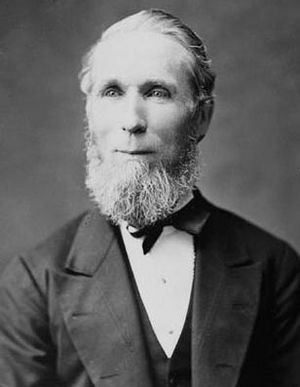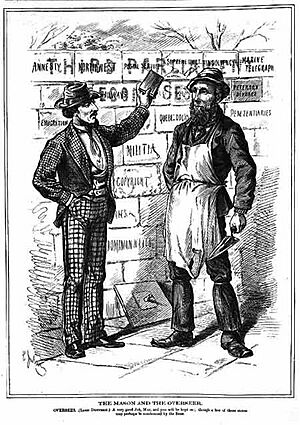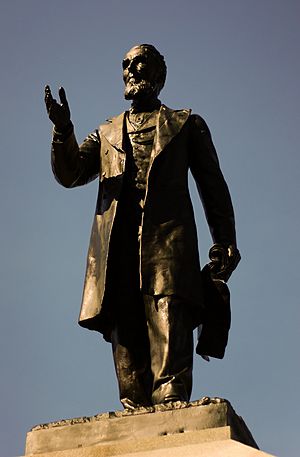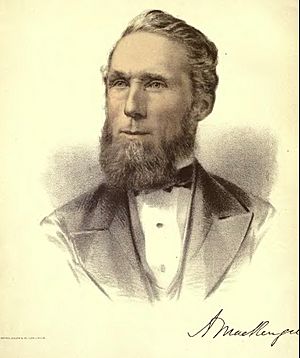Alexander Mackenzie (politician) facts for kids
Quick facts for kids
Alexander Mackenzie
|
|
|---|---|

Mackenzie in 1878
|
|
| 2nd Prime Minister of Canada | |
| In office November 7, 1873 – October 8, 1878 |
|
| Monarch | Victoria |
| Governor General | The Earl of Dufferin |
| Preceded by | John A. Macdonald |
| Succeeded by | John A. Macdonald |
| Leader of the Liberal Party | |
| In office March 6, 1873 – May 4, 1880 |
|
| Preceded by | Edward Blake |
| Succeeded by | Edward Blake |
| Member of the House of Commons of Canada | |
| In office September 20, 1867 – April 17, 1892 |
|
| More... | |
| Personal details | |
| Born | January 28, 1822 Logierait, Scotland |
| Died | April 17, 1892 (aged 70) Toronto, Ontario, Canada |
| Resting place | Lakeview Cemetery, Sarnia, Ontario |
| Political party | Liberal |
| Spouses |
Helen Neil
(m. 1845; died 1852)Jane Sym
(m. 1853) |
| Children | 3 |
| Signature |  |
| Military service | |
| Allegiance | Canada |
| Branch/service | Canadian militia |
| Years of service | 1866–1874 |
| Rank | Major |
| Unit | 27th (Lambton) Battalion of Infantry |
Alexander Mackenzie (January 28, 1822 – April 17, 1892) was the second Prime Minister of Canada. He held this important job from 1873 to 1878.
Mackenzie was born in Logierait, Perthshire, Scotland. He had to leave school at age 13 after his father died to help his family. He learned to be a stonemason. When he was 19, Mackenzie moved to Canada, settling in what is now Ontario.
His stonemasonry business did very well. This allowed him to explore other interests, like editing a newspaper that supported political reform. In 1862, Mackenzie was elected to the Legislative Assembly of the Province of Canada.
In 1867, Mackenzie became a Member of Parliament (MP) for the new House of Commons of Canada with the Liberal Party. He became the leader of the Liberal Party in 1873. A few months later, he became Prime Minister after John A. Macdonald resigned due to a scandal.
Mackenzie and the Liberals won a clear majority in the 1874 election. People liked him because he came from a humble background and seemed very fair.
As Prime Minister, Mackenzie continued to build the new country of Canada. His government created the Supreme Court of Canada and the Royal Military College of Canada. They also formed the District of Keewatin to manage Canada's new western lands. However, his government struggled with a worldwide economic downturn. They also made slow progress on the transcontinental railway.
In the 1878 election, Mackenzie's government lost badly. He remained the leader of the Liberal Party for two more years. He continued to serve as an MP until he died from a stroke.
Contents
Early Life and Work
Alexander Mackenzie was born on January 28, 1822, in Logierait, Scotland. He was one of 10 boys, but only seven lived past infancy. His father was a carpenter. When Alexander was 13, his father died, and he had to stop school to help his family.
He became a stonemason and met Helen Neil, who would become his first wife. In 1842, Mackenzie and the Neil family moved to Canada to find a better life. They settled in Kingston, Ontario.
Mackenzie worked on many construction projects. He helped build a bomb-proof arch at Fort Henry. He was also a foreman for the construction of the Welland Canal and the Lachine Canal. While working, a heavy stone fell and hurt his leg. He recovered but never fully regained strength in that leg.
In Kingston, Mackenzie spoke out against unfair religious and political practices. He also opposed corruption in government.
In 1845, Mackenzie married Helen Neil (1826–1852). They had three children, but only one daughter, Mary, survived. In 1847, they moved to Sarnia, Ontario. Mackenzie's brothers and mother soon joined them from Scotland.
He became a general contractor and was known for being hardworking and honest. He helped build many courthouses and jails in southern Ontario. Some of these buildings, like the Mackenzie Hall Cultural Centre in Windsor, are still standing today. Helen died in 1852. In 1853, he married Jane Sym (1825–1893).

Starting in Politics
Mackenzie became involved in politics almost as soon as he arrived in Canada. He strongly believed in equality for everyone. In 1851, he became the secretary for the Reform Party in Lambton.
He worked hard to help George Brown, who owned a reformist newspaper called The Globe, win his first seat in 1851. Mackenzie and Brown became close friends. In 1852, Mackenzie became the editor of another reformist newspaper, the Lambton Shield.
In 1861, Alexander Mackenzie was elected to the Legislative Assembly. He supported George Brown. In 1865, when Brown left a political alliance, Mackenzie was asked to take his place. But Mackenzie refused, staying true to his beliefs and being careful about Macdonald's plans.
In 1867, he entered the House of Commons of Canada, representing the Lambton area in Ontario. At that time, there wasn't a strong national Liberal Party. Mackenzie didn't think he was the best person to lead, but he became the unofficial leader of the opposition.
Prime Minister (1873–1878)
When Macdonald's government resigned in 1873 due to the Pacific Scandal, the Governor General, Lord Dufferin, asked Mackenzie to form a new government. Mackenzie had just been chosen as the leader of the Liberal Party.
Mackenzie formed his government and asked for an election in January 1874. The Liberals won a majority of seats in the House of Commons.
Mackenzie was Prime Minister until the 1878 election. In that election, Macdonald's Conservatives won back power. It was unusual for someone from Mackenzie's humble background to reach such a high position.
Mackenzie also served as the Minister of Public Works. He oversaw the completion of the Parliament buildings. He even designed a secret staircase from his office to avoid people asking for favours. Mackenzie disliked this system of political favours, but he used it when necessary to keep his party united.
Mackenzie believed strongly in democratic ideals. He refused the offer of a knighthood three times. This made him the only one of Canada's first eight Prime Ministers not to be knighted. He was proud of his working-class background. Once, while visiting Fort Henry as Prime Minister, he told a soldier the exact thickness of a wall, saying, "I know, because I built it myself!"
As Prime Minister, Alexander Mackenzie worked to improve and simplify how the government worked. He introduced the secret ballot for voting. He also helped create the Supreme Court of Canada and the Royal Military College of Canada in Kingston in 1874. He also established the Office of the Auditor General in 1878.
He completed the Intercolonial Railway. However, he struggled to make progress on the national railway because of a worldwide economic downturn. Mackenzie stood up for Canada's rights as a nation and fought for honesty in government. He was known for his honesty and integrity.
His time as Prime Minister was affected by an economic downturn that began in 1873. Mackenzie's government found it hard to fix the economy. In 1874, he made a new free trade agreement with the United States. This removed high taxes on Canadian goods sold in the US. However, this did not boost the economy much, and railway construction slowed down.
In 1876, the Conservative opposition proposed a "National Policy" of protective tariffs (taxes on imported goods). This idea was popular with voters. In the election at the end of Mackenzie's term, the Conservatives won by a landslide.
Supreme Court Appointments
During his time as Prime Minister, Alexander Mackenzie chose the first judges for the Supreme Court of Canada. These judges were appointed by the Governor General.
- Sir William Buell Richards (Chief Justice) – September 30, 1875
- Sir William Johnstone Ritchie – September 30, 1875
- Sir Samuel Henry Strong – September 30, 1875
Later Life and Legacy
After his government lost the election, Mackenzie remained the Leader of the Opposition for two more years, until 1880. In 1881, he became the first president of The North American Life Assurance Company.
He later became ill, losing much of his strength and almost his voice. He remained an MP until his death in 1892 from a stroke. He died in Toronto and was buried in Lakeview Cemetery in Sarnia, Ontario.
Character and Reputation
Mackenzie was a very honest and principled man. He was a devout Baptist. He found strength in his family, friends, and faith. He was also a loyal friend and enjoyed playing pranks.
He was humble and down-to-earth. While he was strict in public, he was kind and giving in private. He was known for his honour and integrity. He did not seek personal fame or wealth.
Lord Dufferin, Canada's Governor General, described him as "as pure as crystal, and as true as steel, with lots of common sense." Sir Wilfrid Laurier, who later became Prime Minister, said Mackenzie was "one of the truest and strongest characters to be met within Canadian history."
Newspapers around the world praised him. The London Times noted his "untiring energy, the business-like accuracy, the keen perception and reliable judgment, and above all the inflexible integrity." The Montreal Star called him "one of the very foremost architects of the Canadian nationality."
Places Named After Him
Many places and things are named in honour of Alexander Mackenzie:
- The Mackenzie Mountain Range in the Yukon and Northwest Territories.
- Mount Mackenzie, in British Columbia.
- The Mackenzie Building at the Royal Military College of Canada in Kingston. The college band also uses the Mackenzie tartan.
- Mackenzie Hall in Windsor, Ontario.
- Alexander Mackenzie Park in Sarnia, Ontario.
- Alexander Mackenzie High School in Sarnia.
- Mackenzie Avenue in Ottawa, Ontario.
- Mackenzie Tower, in the West Block on Parliament Hill, Ottawa.

Other Honours
- A monument marks his tomb in Lakeview Cemetery, Sarnia, Ontario.
- A painting titled "Honourable Alexander Mackenzie" (1964) by Lawren Harris hangs in the Mackenzie Building at the Royal Military College of Canada.
See also
 In Spanish: Alexander Mackenzie (político) para niños
In Spanish: Alexander Mackenzie (político) para niños
- List of prime ministers of Canada



